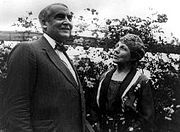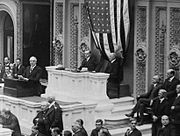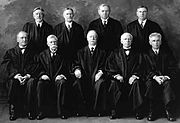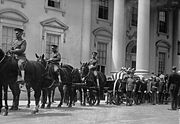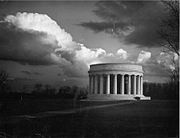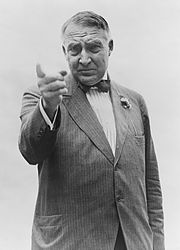
Warren G. Harding
Background Information
This selection is made for schools by a children's charity read more. SOS Children has looked after children in Africa for forty years. Can you help their work in Africa?
| Warren G. Harding | |
|---|---|
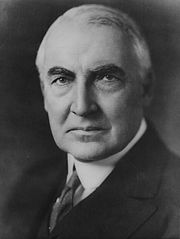 |
|
| 29th President of the United States | |
| In office March 4 1921 – August 2 1923 |
|
| Vice President | Calvin Coolidge (1921–1923) |
| Preceded by | Woodrow Wilson |
| Succeeded by | Calvin Coolidge |
| United States Senator from Ohio |
|
| In office January 4 1915 – March 4 1921 |
|
| Preceded by | Theodore E. Burton |
| Succeeded by | Frank B. Willis |
| 28th Lieutenant Governor of Ohio | |
| In office January 11 1904 – January 8 1906 |
|
| Governor | Myron T. Herrick |
| Preceded by | Harry L. Gordon |
| Succeeded by | Andrew L. Harris |
| Ohio State Senator | |
| In office 1899 – 1903 |
|
| Personal details | |
| Born | November 2, 1865 Near Blooming Groove, Ohio |
| Died | August 2, 1923 (aged 57) San Francisco, California |
| Nationality | American |
| Political party | Republican |
| Spouse(s) | Florence Kling Harding |
| Alma mater | Ohio Central College |
| Occupation | Businessman (Newspapers) |
| Religion | Baptist |
| Signature | |
Warren Gamaliel Harding ( November 2 1865 – August 2 1923) was an American politician, and the twenty-ninth President of the United States, serving from 1921 to 1923, his term ending as he died from a heart attack at age 57. A Republican from Ohio, Harding was an influential newspaper publisher. He served in the Ohio Senate (1899–1903) and later as Lieutenant Governor of Ohio (1903–1905) and as a U.S. Senator (1915–1921).
His political leanings were conservative, which enabled him to become the compromise choice at the 1920 Republican National Convention. During his presidential campaign, held in the aftermath of World War I, he promised a return to " normalcy"; and, in the 1920 election, he defeated his Democratic opponent, fellow Ohioan James M. Cox, in the biggest landslide in American history—60.36% to 34.19%.
Harding headed a cabinet of notable men such as Charles Evans Hughes, Andrew Mellon, Herbert Hoover and Secretary of the Interior Albert B. Fall, who was jailed for his involvement in the Teapot Dome scandal. In foreign affairs, Harding signed peace treaties that built on the Treaty of Versailles (which formally ended World War I). He also led the way to world Naval disarmament at the Washington Naval Conference of 1921–22.
By many, Harding is ranked as one of the least successful U.S. Presidents, despite having been immensely popular while in office.
Early life
Warren G. Harding was born November 2, 1865, near Marion, Ohio (in a town now called Blooming Grove, Ohio). Harding was the eldest of eight children born to Dr. George Tryon Harding, Sr. and Phoebe Elizabeth (Dickerson) Harding. His mother was a midwife and later obtained her medical license, and his father taught at a rural school north of Mount Gilead, Ohio. One of Harding's great grandparents may have been African American. When Harding was a teenager, the family moved to Caledonia, Ohio in neighboring Marion County, when Harding's father acquired The Argus, a local weekly newspaper there. It was at The Argus that Harding learned the basics of the journalism business. He continued studying the printing and newspaper trade as a college student at Ohio Central College in Iberia, Ohio, during which time he also worked at the Union Register in Mount Gilead.
After graduating, Harding moved to Marion, Ohio, where he and two friends raised $300 with which to purchase the failing Marion Daily Star, the weakest of the growing city's three newspapers. Harding revamped the paper's editorial platform to support the Republican Party, and enjoyed a moderate degree of success. However, his political stance put him at odds with those who controlled Marion's local politics. Thus when Harding moved to unseat the Marion Independent as the official paper of daily record, he met with vocal resistance from local figures, such as Amos Hall Kling, one of Marion's wealthiest real estate speculators.
While Harding won the war of words and made the Marion Daily Star one of the most popular newspapers in the county, the battle took a toll on his health. In 1889, when Harding was 24, he suffered from exhaustion and nervous fatigue. He spent several weeks at the Battle Creek Sanitarium to regain his strength, ultimately making five visits over fourteen years. Harding later returned to Marion to continue operating the paper. He spent his days boosting the community on the editorial pages, and his evenings " bloviating" (Harding's term for "informally conversing") with his friends over games of poker.
On July 8, 1891, Harding married Florence Kling, the daughter of his nemesis, Amos Hall Kling. Florence Kling was a divorcée, five years Harding's senior, and the mother of a young son, Marshall Eugene DeWolfe. She had pursued Harding persistently, until he reluctantly proposed. Florence's father was furious with his daughter's decision to marry Harding, forbidding his wife from attending the wedding and not speaking to his daughter or son-in-law for eight years.
The couple complemented one another, with Harding's affable personality balancing his wife's no-nonsense approach to life. Florence Harding, exhibiting her father's determination and business sense, turned the Marion Daily Star into a profitable business. She has been credited with helping Harding achieve more than he might have alone; some have speculated that she later pushed him all the way to the White House.
Harding was a Freemason, raised to the Sublime Degree of a Master Mason on August 27 1920, in Marion Lodge #70, F.& A.M., in Marion, Ohio.
Political career
As an influential newspaper publisher with a flair for public speaking, Harding was elected to the Ohio State Senate in 1899. He served four years before being elected Lieutenant Governor of Ohio, a post he occupied from 1903 to 1905. His leanings were conservative, and his record in both offices was relatively undistinguished. He received the Republican nomination for Governor of Ohio in 1910, but lost to incumbent Judson Harmon.
U.S. Senator
In 1912, Harding gave the nominating speech for incumbent President William Howard Taft at the Republican National Convention and in 1914 he was elected to the United States Senate. He served in the Senate from 1915 until his inauguration as President on March 4, 1921, becoming the first sitting Senator to be elected President of the United States.
Joseph Nathan Kane's book, Facts About the Presidents, stated that Harding was "the second President elected while a Senator." This becomes a matter of semantics. On January 13, 1880, the Ohio legislature appointed James A. Garfield, who was then a Congressman from Ohio, to the U.S. Senate beginning March 4, 1881 (at that time, Senators were elected by state legislatures rather than directly by the citizens). He won the Presidential election on November 2, so on that date he was at once Congressman, Senator, and President-elect. Garfield accepted the Presidential election and soon relinquished the other offices. He never actually sat in the Senate seat.
Because of the technicality, Harding continues to be generally considered the first "truly" sitting Senator to become President, Kennedy being the second. For example, George Will referred to Harding that way in his Newsweek commentary in the issue of June 16, 2008, p.60, in pointing out that the two presumptive candidates in the 2008 race are both sitting Senators.
In his book, Blink, Malcolm Gladwell became the latest of a long string of political pundits and ordinary voters who felt that Warren Harding's electoral success was based on his appearance, essentially that he "looked like a president". Gladwell argues that people's first impression of Harding tended to be so highly favorable that it gave them a fixed and very high opinion of Harding, which could not be shaken unless his intellectual and other deficiencies became glaring. Gladwell even refers to the flawed process by which people make decisions as 'Warren Harding Error.'
Election of 1920
Relatively unknown outside his own state, Harding was a true " dark horse" candidate, winning the Republican Party nomination due to the political machinations of his friends after the nominating convention had become deadlocked. Republican leaders met in a smoke-filled room at the Blackstone Hotel in Chicago to end the deadlock. Before receiving the nomination, he was asked whether there were any embarrassing episodes in his past that might be used against him. His formal education was limited, he had a longstanding affair with the wife of an old friend, and he was a social drinker in the time of Prohibition. However, Harding answered "No" and the Party moved to nominate him, only to discover later his relationship with Carrie Fulton Phillips.
In the 1920 election, Harding ran against Democratic Ohio Governor James M. Cox, whose running-mate was Assistant Secretary of the Navy Franklin D. Roosevelt. The election was seen in part as a referendum on whether to continue with the " progressive" work of the Woodrow Wilson Administration or to revert to the " laissez-faire" approach of the William McKinley era.
Harding ran on a promise to "Return to Normalcy", a seldom-used term he popularized. The slogan called an end to the abnormal era of the Great War, along with a call to reflect three trends of his time: a renewed isolationism in reaction to the War, a resurgence of nativism, and a turning away from the government activism of the reform era.
Harding's "front porch campaign" during the late summer and fall of 1920 captured the imagination of the country. Not only was it the first campaign to be heavily covered by the press and to receive widespread newsreel coverage, but it was also the first modern campaign to use the power of Hollywood and Broadway stars, who traveled to Marion for photo opportunities with Harding and his wife. Al Jolson, Lillian Russell, Douglas Fairbanks, and Mary Pickford were among the conservative-minded luminaries to make the pilgrimage to central Ohio. Business icons Thomas Edison, Henry Ford, and Harvey Firestone also lent their cachet to the campaign. From the onset of the campaign until the November election, over 600,000 people traveled to Marion to participate.
The campaign owed a great deal to Florence Harding, who played perhaps a more active role than any previous candidate's wife in a presidential race. She cultivated the relationship between the campaign and the press. As the business manager of the Star, she understood reporters and their industry and played to their needs by making herself freely available to answer questions, pose for pictures, or deliver food prepared in her kitchen to the press office, which was a bungalow she had constructed at the rear of their property in Marion. Mrs. Harding even went so far as to coach her husband on the proper way to wave to newsreel cameras to make the most of coverage.
The campaign also drew upon Harding's popularity with women. Considered handsome, Harding photographed well compared to Cox. However, it was Harding's support for women's suffrage in the Senate that made him popular with women: the ratification of the 19th Amendment in August 1920 brought huge crowds of women to Marion, Ohio to hear Harding. Immigrant groups who had made up an important part of the Democratic coalition such as the Germans and Irish also voted for Harding in the election in reaction to their perceived persecution by the Wilson administration during the war.
During the campaign, rumors spread that Harding's great-great-grandfather was a West Indian black and that other blacks might be found in his family tree. In response, Harding's campaign manager said, "No family in the state (of Ohio) has a clearer, a more honorable record than the Hardings, a blue-eyed stock from New England and Pennsylvania, the finest pioneer blood." The rumors, based perhaps on no more than local gossip, were circulated by William Estabrook Chancellor. The rumors may have been sustained by a statement Harding allegedly made to newspaperman James W. Faulkner on the subject, perhaps meaning to be dismissive: "How do I know, Jim? One of my ancestors may have jumped the fence."
The election of 1920 was the first in which women could vote nationwide. It was also the first presidential election to be covered on the radio, thanks to the nation's first commercial radio station, KDKA in Pittsburgh, Pennsylvania. Harding received 60% of the national vote and 404 electoral votes, an unprecedented margin of victory. Cox received 34% of the national vote and 127 electoral votes. Socialist Eugene V. Debs, campaigning from a federal prison, received 3% of the national vote. Debs was in prison for opposing Wilson's draft; despite the many political differences between the two candidates, when Harding became President, he pardoned Debs.
Presidency 1921–1923
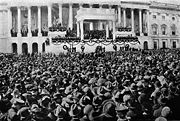
The administration of Warren G. Harding followed the Republican platform approved at the 1920 Republican National Convention, which was held in Chicago.
Harding pushed for the establishment of the Bureau of Veterans Affairs (later organized as the Department of Veterans Affairs), the first permanent attempt at answering the needs of those who had served the nation in time of War.
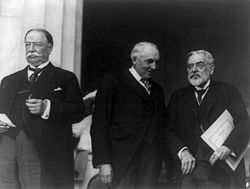
In April 1921, speaking before a joint session of Congress he called for peacemaking with Germany and Austria, emergency tariffs, new immigration laws, regulation of radio and trans cable communications retrenchment in government, tax reduction, repeal of wartime excess profits tax, reduction of railroad rates, promotion of agricultural interests, a national budget system, a great merchant marine and a department of public welfare. He also called for the abolition of lynching, but he did not want to make enemies in his own party and with the Democrats and did not fight for his program.
The Hardings visited their home community of Marion, Ohio once during the term when the city celebrated its Centennial during the first week of July. The President arrived on July 3, gave a speech to the community at the Marion County Fairgrounds on July 4, and left the following morning for other speaking commitments.
Major events during presidency
- Peace treaties signed with Germany, Austria and Hungary, formally ending World War I for the United States
- Established the Veterans' Bureau, later incorporated into the Veterans Administration and ultimately the Department of Veterans Affairs
- Treaty to indemnify Colombia for its loss of Panama
- Matewan Massacre in West Virginia
- Washington Naval Conference 1921–1922
- Budget and Accounting Act of 1921
- Revenue Act of 1921
- Fordney-McCumber Tariff 1922
- Teapot Dome scandal
- Created the Naval Petroleum Reserve Number 4, 1923 (now the National Petroleum Reserve-Alaska)
- Resignation of Harding's Attorney General for accepting bribes
- Pardon of war protester Eugene Debs and other political prisoners
Administration and cabinet
| The Harding Cabinet | ||
|---|---|---|
| OFFICE | NAME | TERM |
| President | Warren G. Harding | 1921–1923 |
| Vice President | Calvin Coolidge | 1921–1923 |
| Secretary of State | Charles Evans Hughes | 1921–1923 |
| Secretary of the Treasury | Andrew Mellon | 1921–1923 |
| Secretary of War | John W. Weeks | 1921–1923 |
| Attorney General | Harry M. Daugherty | 1921–1923 |
| Postmaster General | Will H. Hays | 1921–1922 |
| Hubert Work | 1922–1923 | |
| Harry S. New | 1923 | |
| Secretary of the Navy | Edwin Denby | 1921–1923 |
| Secretary of the Interior | Albert B. Fall | 1921–1923 |
| Hubert Work | 1923 | |
| Secretary of Agriculture | Henry C. Wallace | 1921–1923 |
| Secretary of Commerce | Herbert Hoover | 1921–1923 |
| Secretary of Labor | James J. Davis | 1921–1923 |
Supreme Court appointments
Harding appointed the following justices to the Supreme Court of the United States:
- William Howard Taft – Chief Justice – 1921
- Harding was the only President to have appointed a previous President to the Supreme Court.
- George Sutherland – 1922
- Pierce Butler – 1923
- Edward Terry Sanford – 1923
Administrative scandals
Upon winning the election, Harding appointed many of his old allies to prominent political positions. Known as the " Ohio Gang" (a term used by Charles Mee, Jr., in his book of the same name), some of the appointees used their new powers to rob the government. It is unclear how much, if anything, Harding himself knew about his friends' illicit activities.
The most infamous scandal of the time was the Teapot Dome affair, which shook the nation for years after Harding's death. The scandal involved Secretary of the Interior Albert B. Fall, who was convicted of accepting bribes and illegal no-interest personal loans in exchange for the leasing of public oil fields to business associates. (Absent the bribes and personal loans, the leases themselves were quite legal.) In 1931, Fall became the first member of a Presidential Cabinet to be sent to prison.
Thomas W. Miller, head of the Office of Alien Property, was convicted of accepting bribes. Jess Smith, personal aide to the Attorney General, destroyed papers and then committed suicide. Charles Forbes, Director of the Veterans Bureau, skimmed profits, earned large amounts of kickbacks, and directed underground alcohol and drug distribution. He was convicted of fraud and bribery and drew a two-year sentence. Charles Cramer, an aide to Charles Forbes, committed suicide.
No evidence to date suggests that Harding personally profited from these crimes, but he was apparently unable to stop them. "I have no trouble with my enemies," Harding told journalist William Allen White late in his presidency, "but my damn friends, they're the ones that keep me walking the floor nights!"
Historian Wyn Craig Wade, in his 1987 book The Fiery Cross, suggests that Harding had ties with the Ku Klux Klan, perhaps even having been inducted into the organization in a private White House ceremony. Evidence includes the taped testimony of one of the members of the alleged induction team, however beyond that it is scant at best and the theory is generally discounted.
Death
In June 1923, Harding set out on a cross-country "Voyage of Understanding," planning to meet ordinary people and explain his policies. During this trip, he became the first president to visit Alaska. Rumors of corruption in his administration were beginning to circulate in Washington by this time, and Harding was profoundly shocked by a long message he received while in Alaska, apparently detailing illegal activities previously unknown to him. At the end of July, while traveling south from Alaska through British Columbia, he developed what was thought to be a severe case of food poisoning. He gave the final speech of his life to a large crowd at the University of Washington Stadium (now Husky Stadium) at the University of Washington campus in Seattle, Washington. A scheduled speech in Portland, Oregon was canceled. The President's train proceeded south to San Francisco. Arriving at the Palace Hotel, he developed pneumonia. Harding died of either a heart attack or a stroke at 7:35 p.m. on August 2 1923. The formal announcement, printed in the New York Times of that day, stated that "A stroke of apoplexy was the cause of death." He had been ill exactly one week.
Naval physicians surmised that he had suffered a heart attack; however, this diagnosis was not made by Dr. Charles E. Sawyer, the Surgeon General, who was traveling with the presidential party. Mrs. Harding refused permission for an autopsy, which soon led to speculation that the President had been the victim of a plot, possibly carried out by his wife. Gaston B. Means, an amateur historian and gadfly, noted in his book The Strange Death of President Harding (1930) that the circumstances surrounding his death lent themselves to some suspecting he had been poisoned. Several individuals attached to him, personally, and politically, would have welcomed Harding's death, as they would have been disgraced in association by Means' assertion of Harding's "imminent impeachment". Although Means was later discredited for publicly accusing Mrs. Harding of the murder, enough doubts surround the President's death to keep reputable scholars open to the possibility of murder.
Harding was succeeded by Vice President Calvin Coolidge, who was sworn in by his father, a Justice of the Peace, in Plymouth Notch, Vermont.
Following his death, Harding's body was returned to Washington, where it was placed in the East Room of the White House pending a state funeral at the United States Capitol. White House employees at the time were quoted as saying that the night before the funeral, they heard Mrs. Harding speak for more than an hour to her dead husband.
Harding was entombed in the receiving vault of the Marion Cemetery, Marion, Ohio, in August 1923. Following Mrs. Harding's death on November 21, 1924, she too was temporarily buried next to her husband. Both bodies were moved in December 1927 to the newly completed Harding Memorial in Marion, which was dedicated by President Herbert Hoover in 1931. The lapse between the final interment and the dedication was partly because of the aftermath of the Teapot Dome scandal.
At the time of his death, Harding was also survived by his father. Harding and John F. Kennedy are the only two presidents to have predeceased their fathers. They are also the only two presidents to have been elected while serving as senators.
Personal scandals and allegations
The extent to which Harding engaged in extramarital affairs is somewhat controversial. It has been recorded in primary documents that Harding had an affair with Carrie Fulton Phillips; Nan Britton wrote The President's Daughter in 1927, documenting her affair and the alleged child (Elizabeth Ann) with Harding.
Rumors of the Harding love letters circulated through Marion, Ohio, for many years. However, their existence was not confirmed until 1968, when author Francis Russell gained access to them during his research for his book, The Shadow of Blooming Grove. The letters were in the possession of Phillips. Phillips kept the letters in a box in a closet and was reluctant to share them. Russell persuaded her to relent, and the letters showed conclusively that Harding had a 15-year relationship with Mrs. Phillips, who was then the wife of his friend James Phillips, owner of the local department store, the Uhler-Phillips Company. Mrs. Phillips was almost eight years younger than Harding. By 1915, she began pressing Harding to leave his wife. When he refused, she left her husband and moved to Berlin with her daughter Isabel. However, as the United States became increasingly likely to be drawn into World War I, Mrs. Phillips moved back to the U.S. and the affair reignited. Harding was now a U.S. Senator, and a vote was coming up on a declaration of war against Germany.
Mrs. Phillips threatened to go public with their affair if the Senator supported the war, but Harding defied her and voted for war, and Phillips did not reveal the scandal to the world. When Harding won the Republican Presidential nomination in 1920, he did not disclose the relationship to party officials. Once they learned of the affair, it was too late to find another nominee. To reduce the likelihood of a scandal breaking, the Republican National Committee sent Phillips and her family on a trip to Japan and paid them over $50,000. She also received monthly payments thereafter, becoming the first and only person known to have successfully extorted money from a major political party in the United States.
The letters Harding wrote to Mrs. Phillips were confiscated at the request of the Harding heirs, who requested and received a court injunction prohibiting their inclusion in Russell's book. Russell in turn left quoted passages from the letters as blank passages in protest against the Harding heirs' actions. The Harding-Phillips love letters remain under an Ohio court protective order that expires in 2023, 100 years after Harding's death, after which the content of the letters may be published or reviewed.
Besides Mrs. Phillips, Harding also reportedly had an affair with Nan Britton, the daughter of Harding's friend Dr. Britton of Marion. Britton's claim that he had fathered her child was widely circulated in the years just after Harding's death, and it is often cited as one of the best-known "facts" about Harding, but it has not been proven to the satisfaction of most historians.
Nan Britton's obsession with Harding started at an early age when she began pasting pictures of Senator Harding on her bedroom walls. According to Britton's book The President's Daughter, she and Senator Harding conceived a daughter, Elizabeth Ann, in January of 1919, in his Senate office. Elizabeth Ann was born on October 22 1919. Harding never met Elizabeth Ann but paid large amounts of child support. Harding and Britton, according to unsubstantiated reports, continued their affair while he was President, using a closet adjacent to the Oval Office for privacy. Following Harding's death, Britton unsuccessfully sued the estate of Warren G. Harding on behalf of Elizabeth Ann. Under cross-examination by Harding heirs' attorney, Grant Mouser (a former member of Congress himself), Britton's testimony was riddled with inconsistencies, and she lost her case. Britton married a Mr. Christian, who adopted Elizabeth Ann. In adulthood, Elizabeth Ann married Henry Blaesing and raised a family. During most of her life she shied from press coverage about her alleged birthright, and refused requests for interviews in her later years. She died on November 17, 2005, in Oregon.
Speaking style
Although a commanding and powerful speaker, Harding was notorious for his verbal gaffes, such as his comment "I would like the government to do all it can to mitigate, then, in understanding, in mutuality of interest, in concern for the common good, our tasks will be solved." His errors were compounded by his insistence on writing his own speeches. Although it might not have been a mispronunciation as some thought, Harding's most famous "mistake" was his use of the word "normalcy" when the more correct word to use at the time would have been "normality." Harding decided he liked the sound of the word and made "Return to Normalcy" a recurring theme. Critic H.L. Mencken disagreed, saying of Harding, "He writes the worst English that I have ever encountered. It reminds me of a string of wet sponges; it reminds me of tattered washing on the line; it reminds me of stale bean soup, of college yells, of dogs barking idiotically through endless nights. It is so bad that a sort of grandeur creeps into it. It drags itself out of the dark abysm of pish, and crawls insanely up the topmost pinnacle of posh. It is rumble and bumble. It is flap and doodle. It is balder and dash." Mencken also coined the term "Gamalielese" to refer to Harding's distinctive style of speech, a mocking reference to Harding's middle name rather than a reference to any of the Biblical characters named Gamaliel. Upon Harding's death, poet E. E. Cummings said "The only man, woman or child who wrote a simple declarative sentence with seven grammatical errors is dead."
Some suggest Harding had a form of aphasia.
Memorials
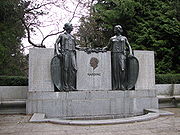
- Warren G. Harding High School, Warren, Ohio
- Warren G. Harding Middle School, Steubenville, Ohio
- Warren G.Harding High School; Bridgeport, Connecticut
- Warren G. Harding Middle School, Philadelphia, Pennsylvania
- Harding Elementary School, Santa Barbara, California
- Harding Memorial, Marion, Ohio.
- Marion Harding High School, Marion, Ohio
- Harding County, New Mexico is named in his honour.
- Ohio Northern University's College of Law was once named after him but was later renamed.
- Harding Park Golf Club in San Francisco is named after him.
- Peace Treaty Marker. Somerville, New Jersey. In 1921, at the estate of New Jersey Governor Joseph S. Frelinghuysen, Warren Harding signed the peace treaty which ended America's involvement in World War I. Today, the estate has been replaced with mini-malls. The marker remains in a patch of grass near a Burger King parking lot along Route 28, just North of the Somerville traffic circle.
- Harding Charter Preparatory High School, Oklahoma City, Oklahoma
- Harding Memorial, Seattle, Washington. In 1925 a memorial was erected to Warren Harding in Seattle to commemorate the site of one of Harding's last public addresses. Prior to making his final speech, on July 27, 1923, at the University of Washington Stadium, Harding's motorcade stopped at Woodland Park, where he led an estimated 50,000 Boy Scouts and children in reciting the Pledge of Allegiance. Starting in 1977, the memorial was demolished and buried under the Woodland Park Zoo's African Savanna exhibit. The memorial's only surviving elements -- two life-sized bronze statues of Boy Scouts that once saluted the memorial's image of Harding -- were relocated to the foyer of the Chief Seattle Council of the Boy Scouts.
